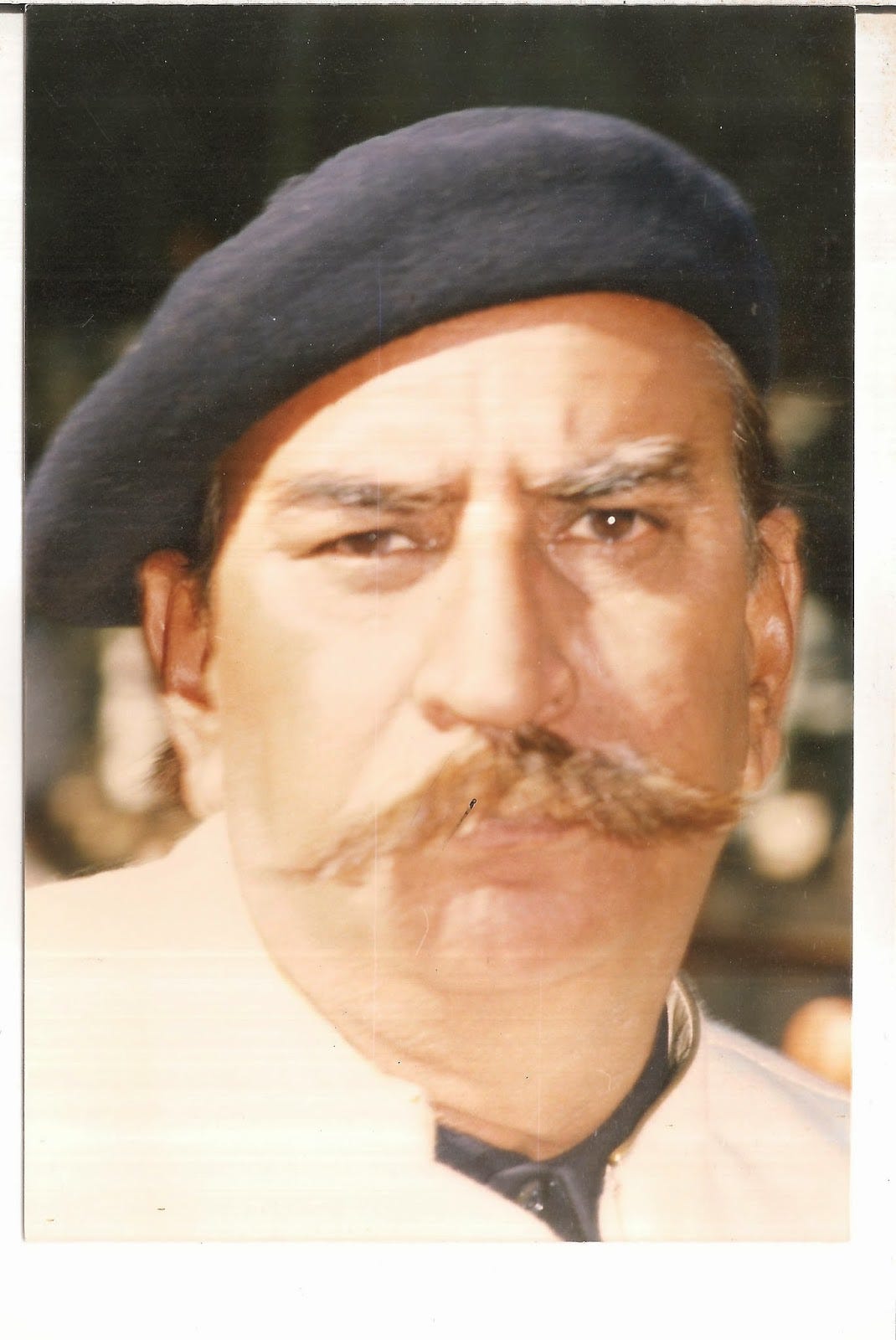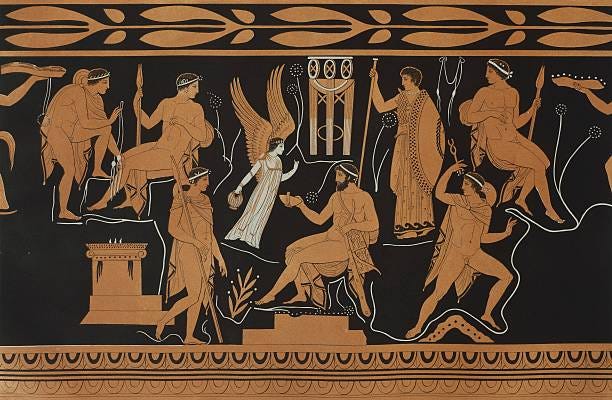The wrestling arena was thronged with visitors attending the vaisakhi fair at Dera Baba Nanak. Colorful turbans seemed to present a vivid map of some springtime orchard. Flaunting bludgeons, hatchets, pikes, long axes, men youthful, middle-aged and elderly all stood together, laved with perspiration, their eyes keenly following the young man pacing about the arena. A full six feet tall, physique unblemished, burly like a bull’s, his face too was exceedingly fetching. He sported red underpants, scrunched between his thighs, on his topknot a red kerchief.
A bludgeon stood firmly planted in the middle of the arena. From it hung a soft rose-hued turban. A kerchief was tied to it as well, with a thousand rupees inside. Right next to it lay a heavy black-colored mace: embedded with nose-pins, tethered to iron spikes hammered into the ground.
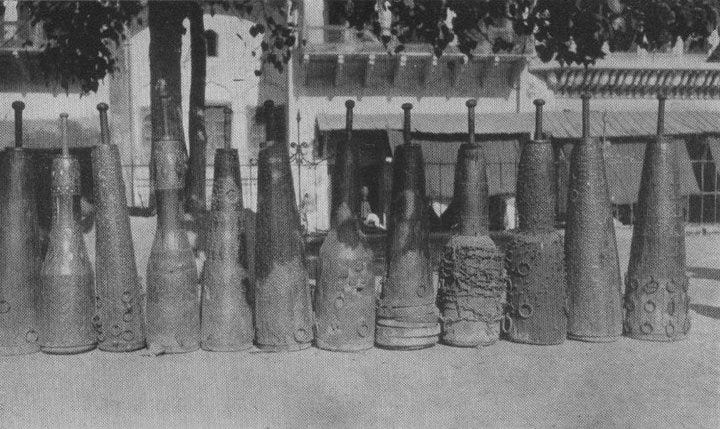
After striding all over the arena, the youth came to a halt next to this mace. He touched his ears and evoked his saintly pir. Then, swinging the mace over his head, he brought it to the ground.
He stood up to steady his breath, his well-oiled body glistening like a bowl of bronze under the late afternoon sun. As the drummer beat his dhol with a stick, the young man began idly ambling around the mace, as if drying his sweat.
A compere, scarf wrapped over his head, cane in hand, pushed the rabble back to clear up space. He stood next to the mace and motioned to the drummer to stop. Once the drumming stopped, the compere raised the arm holding a cane, and spoke to the crowd, “Brothers! This mace-bearing young man here has come from the princely state of Kapurthala. He declares that the man who can swing this mace will be awarded a thousand rupees. One thousand.” He touched the kerchief tied to the turban and added, “Fifty-twenty rupees!”
The compere finished his announcement. The drummer resumed beating his drum. The people broke into a purling chatter, their eyes glued to the strongman and his mace. Outside the arena, horsemen stood up on their horses’ stirrups to look. The young fellow with the mace looked round at the crowd that stood about him one more time, and then stepped away from the mace.
Amongst the crowd in the arena were those who had travelled from afar: wrestlers, kabaddi-playing sturdy young men, robust lifters known for hefting heavy objects. And yet, it seemed as if none standing in that arena could muster the courage to lift the mace. The mace-bearing strongman cocked his neck like a rooster yet again, eyeballing the gathering, as if to taunt them, “Is that all, boys?”
The aging Mangal Singh, standing on his horse, had been watching this unfold with his friend Banta Singh. He fastened the tail of his turban garlanding his neck over his head, and with a long-axe in the other hand, took hold of the horse’s reins. Standing on the stirrups, with a booming voice, he derided the men inside the arena, “Woe upon such youth, you great heroes! Go ahead, someone grab hold of that mace.”
He turned to Banta Singh and exclaimed, “Look at these boys: they’ve been bred and trained like bulls, and yet they’re all hollow on the inside, hollow. They’re all degenerate, not one of them has any blessed vitality left in them.” Mangal Singh seemed to be animated with an extraordinary fervor. Banta Singh laughed at his words, but did not say anything.
The whole arena turned to behold Mangal Singh. Many felt insulted by his comment, but none dared respond in kind. Mangal Singh had given up banditry a long time ago, yes, but he was always ready for a bloody fight. Perhaps due to this fearsome reputation, or on account of his declining eld, he had come to command a certain esteem. He had long crossed fifty years of age, and his beard had turned white as well. To someone who regarded him the first time, he would appear but an old man possessed of middling height and sinewy frame.
Mangal Singh stood up on the stirrups yet again, and yet again he challenged the youth, “Rouse yourselves, lads. He who lifts and swings this mace, I promise to buy him ghee worth two paisas.”
Their pride stirred by Mangal Singh’s louring taunts, five men, renowned for their strength, entered the arena. But the mace would not yield, and they departed after struggling in vain, hiding their faces in humiliation. Mangal Singh almost fell off his saddle in an impassioned fit of rage.
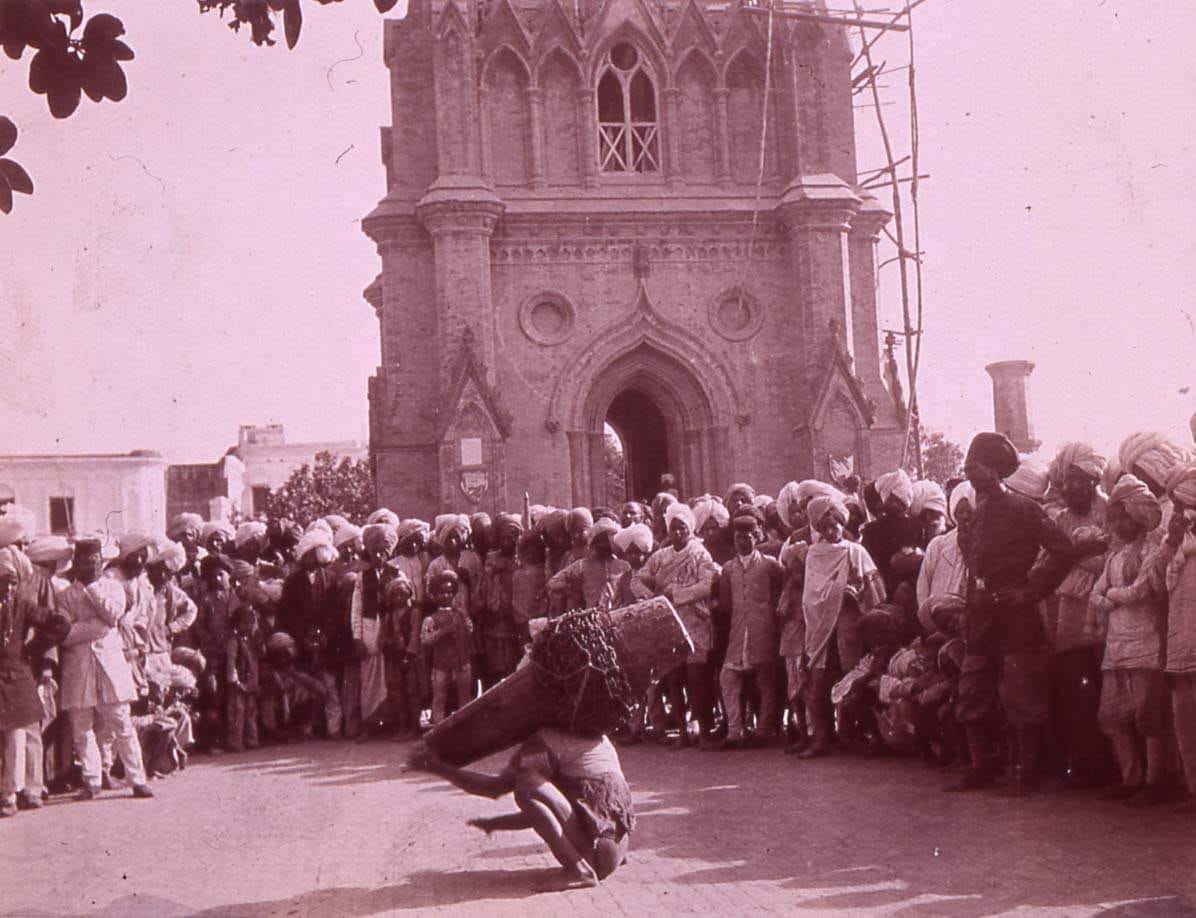
Meanwhile, Mangal’s son Jangal Singh had walked into the arena, securing his loincloth. To descry his son in the arena brought a glint to Mangal Singh’s eyes. He commanded, “Be strong now, Jangal! Today you prove the worth of my upbringing through and through.”
Jangal Singh was an exceptionally strapping young man, and there was none in the area who could match him in lifting the heaviest of weights. Being an only son, he had been raised by Mangal Singh with ample affection and enthusiasm.
Jangal Singh went straight to the mace and grabbed hold of it. People watched with their eyes peeled. Jangal Singh cried out ‘Waheguru’ and threw his weight into the hefty upheave: he lifted the mace up and gripped it in his hands and swung it over his head. But as it passed behind him, the mace’s careening momentum exceeded his grasp, and it fell to the ground, smashing into his heel. Blood sprang from his cleaved heel as if from a fountain.
Mangal Singh felt no regret over this injury: much graver were the wounds he now bore of disgrace and shame. “What is left to say, brother!” he wondered, watching the earth dampen with blood.
Standing close to Mangal Singh, Banta Singh swiftly jumped off his horse. He hurried into the arena, piercing through the crowd. He kneeled and checked the wound on Jangal’s heel. From within the knotted hem of his chaadar, he pulled out a bottle of alcohol and poured it over the wound. He tore a length of cloth from the turban on his shoulder, doused it in the alcohol and wrapped it around the heel. Tying the turban on his head again, he slapped Jangal on the back and said, “God’s mercy, son! No matter… lifting a mace is a matter of strength. To swing it, however, demands skill, and you had never swung a mace before.”
Jangal did not utter a word, and limped out of the arena holding onto Banta Singh’s shoulder.
Mangal Singh observed all of this with a preternatural calm. The mace-bearing strongman looked around at the spectators again— but they had been struck dumb. Mangal Singh gently dismounted from his horse. He held the long axe aloft firmly in his hand as he stepped into the arena.
The mass of people was hewn in two! They cleared afore his path, parting like the sea’s waves. Once inside the arena, Mangal Singh struck an imperious pose. He glared at the mace-bearing strongman.
The spectators held their breath. In that moment, everyone knew in their hearts: this young strongman’s luck had finally run out.
But Mangal Singh said nothing to the strongman, not a word. His gaze bore into the mace. He circled around it once. He placed his long axe on the ground and removed his shoes, then took off his turban and hung it on the prized bludgeon. He fastened his chaadar around his loins, and went up to the mace.
He grasped the mace. In the tensioned silence that encased the arena, one could hear the stunned crowd draw bated breath. The young strongman burst into laughter at the sight of this slightly built man, and took an amused step back, crossing his arms across his chest, fists tucked into armpits.
Mangal Singh gave the cry of ‘Yaa Ali,’ and lifted the mace and held it upright in his hands. His veins flared up, bulging, ready to rupture. His eyes steadily followed the mace held arrect in the air. Rolling the mace in his hands, he deftly assessed its weight and swung it over and behind his head.
A perfect swing— a second — a third.
He swung the heavy mace with the finesse of a gatka master brandishing his cane. The onlookers stood stupefied, turned into stone-fashioned idols. The strongman too could do little but stare at Mangal Singh in disbelief. It was as if Mangal Singh had gone mad.
He kept swinging the mace over his head.
At last, he gained control of the mace and nimbly brought it to a halt on the ground.
His steps unsteady, he staggered towards the prized bludgeon. He caught hold of it, but before he could wrench this bludgeon out of the ground, he collapsed on the ground like a tree severed.
The prized bludgeon was firmly clasped in the fist of the dead Mangal Singh.
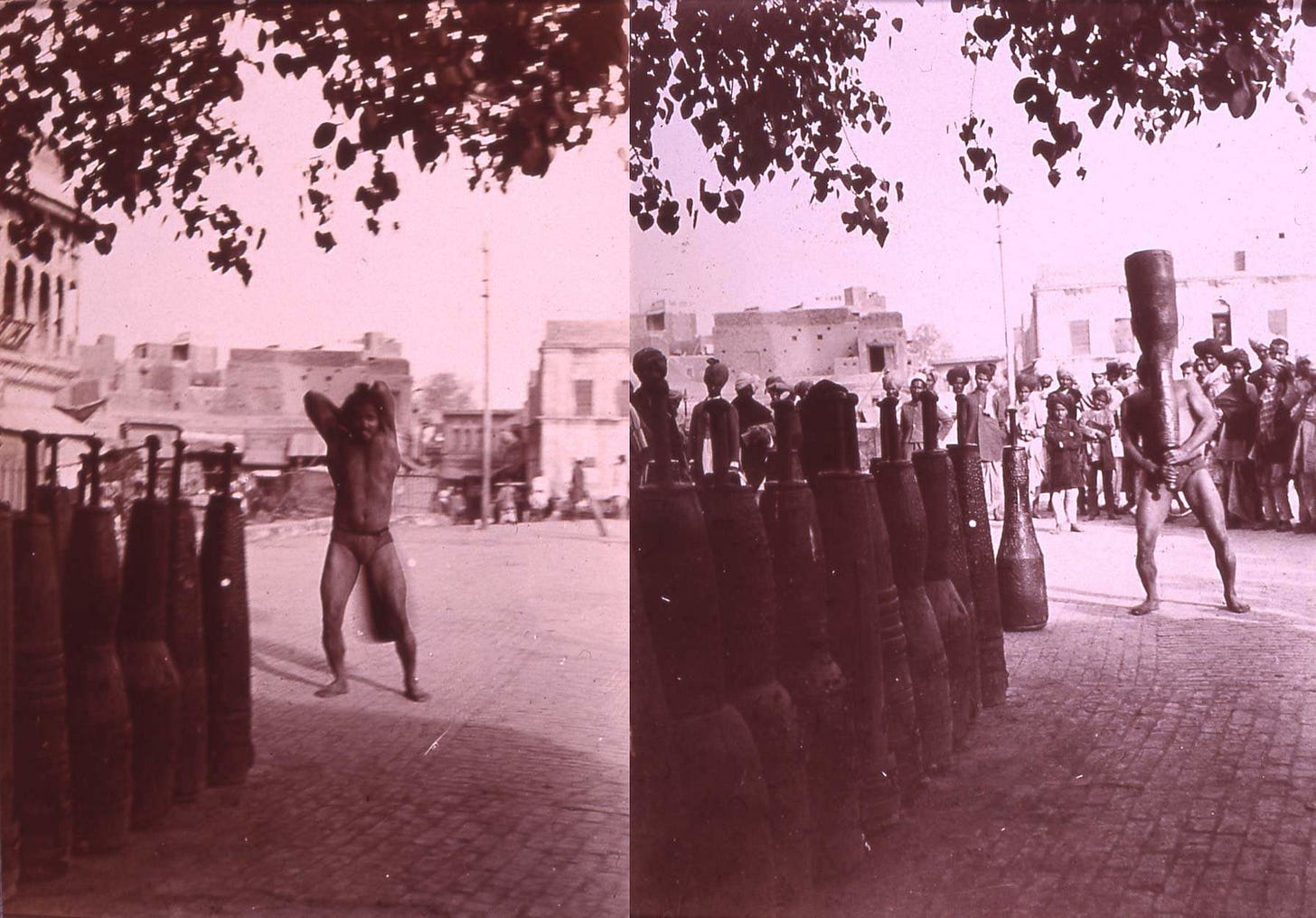
— — -
Afzal Ahsan Randhawa (1937-2017) was an eminent Pakistani Punjabi poet and novelist, a towering figure in modern Punjabi literature. Born in Amritsar, he considered himself a sehajdhari Sikh, and sought to promote Punjab’s cultural heritage (one he was born into and molded by, and continued to cherish) through his work.
He chose to write in Punjabi at a time when the language was deemed ‘coarse’ and ‘seditious’ in Pakistan’s literary circles. His works and interviews reveal a worldview shot through with the layered idioms and archetypes of Punjabi society. He brought to life that world of heroes and rebels, vengeance and honor, rural customs and domestic intrigues, clans and kinship networks: a literary cosmos at once laconic and poetic, brutal and poignant, operating in the interpenetrating folk and epic temporalities that inform all great Punjabi literature.
— — -
Addendum
ਹਉ ਗੋਸਾਈ ਦਾ ਪਹਿਲਵਾਨੜਾ ॥ ਮੈ ਗੁਰ ਮਿਲਿ ਉਚ ਦੁਮਾਲੜਾ ॥ ਸਭ ਹੋਈ ਛਿੰਝ ਇਕਠੀਆ ਦਯੁ ਬੈਠਾ ਵੇਖੈ ਆਪਿ ਜੀਉ ॥੧੭॥— I am the Gosain’s [God’s] wrestler; I have met the Guru, I wear a tall, plumed turban. All have assembled in the wrestling arena, God himself is seated to behold [the contest].
ਵਾਤ ਵਜਨਿ ਟੰਮਕ ਭੇਰੀਆ ॥ ਮਲ ਲਥੇ ਲੈਦੇ ਫੇਰੀਆ ॥ ਨਿਹਤੇ ਪੰਜਿ ਜੁਆਨ ਮੈ ਗੁਰ ਥਾਪੀ ਦਿਤੀ ਕੰਡਿ ਜੀਉ ॥—Bugles resound, drums are beaten; the wrestlers enter the arena and circle around. I throw five strong youths [to the ground], the Guru pats me on the back.
(Guru Granth Sahib, anga 73)
The wrestler’s tapas
Mangal Singh’s tale finds an intriguing parallel in the world of pahalvani that thrived in colonial Lahore. In 1910, a gifted young wrestler named Manni Reniwala collapsed after a ferocious bout against the dreaded Kala Partapa. His promising career, nurtured under the tutelage of the famed Buta Pahalwan, was cut short, and he passed away from a cerebral hemmorhage.
It was said he had produced such a cataclysmic, singularly powerful expenditure of energy that his liver exploded under its strain. The liver (ਕਲੇਜਾ ‘kalejaa’), it must be noted, is considered the subtle seat of vitality and emotion in Punjabi cosmology.
— — -
As an ascetic figure, the pahalwan is placed alongside divine intermediaries such as saints, healers, seers, martyrs (recall Mangal Singh’s cry evoking Imam Ali), lovers, poets, etc. within the Punjabi folk universe. The principle that qualifies the wrestler’s spiritual stature is tapas: variously interpreted as ‘ardor’ by Calasso, as ‘intension’ by Coomaraswamy (from intensify).
Reniwala’s extraordinary act (what Eliade might call gesta), which overwhelmed and exceeded the bounds of life itself, can be understood in terms of tapas. The culmination of rigorous, single-minded austerity. It was the self-annihilating transfiguration of Reniwala’s taut, muscular form into a mirror (door, void, hole) that briefly revealed an enigmatic, lucid, vigorous reality of intensities and force. His liver exploded much like the kundalini serpent tears through the ascetic’s scalp to unveil the thousand-petalled sahasrara chakra.
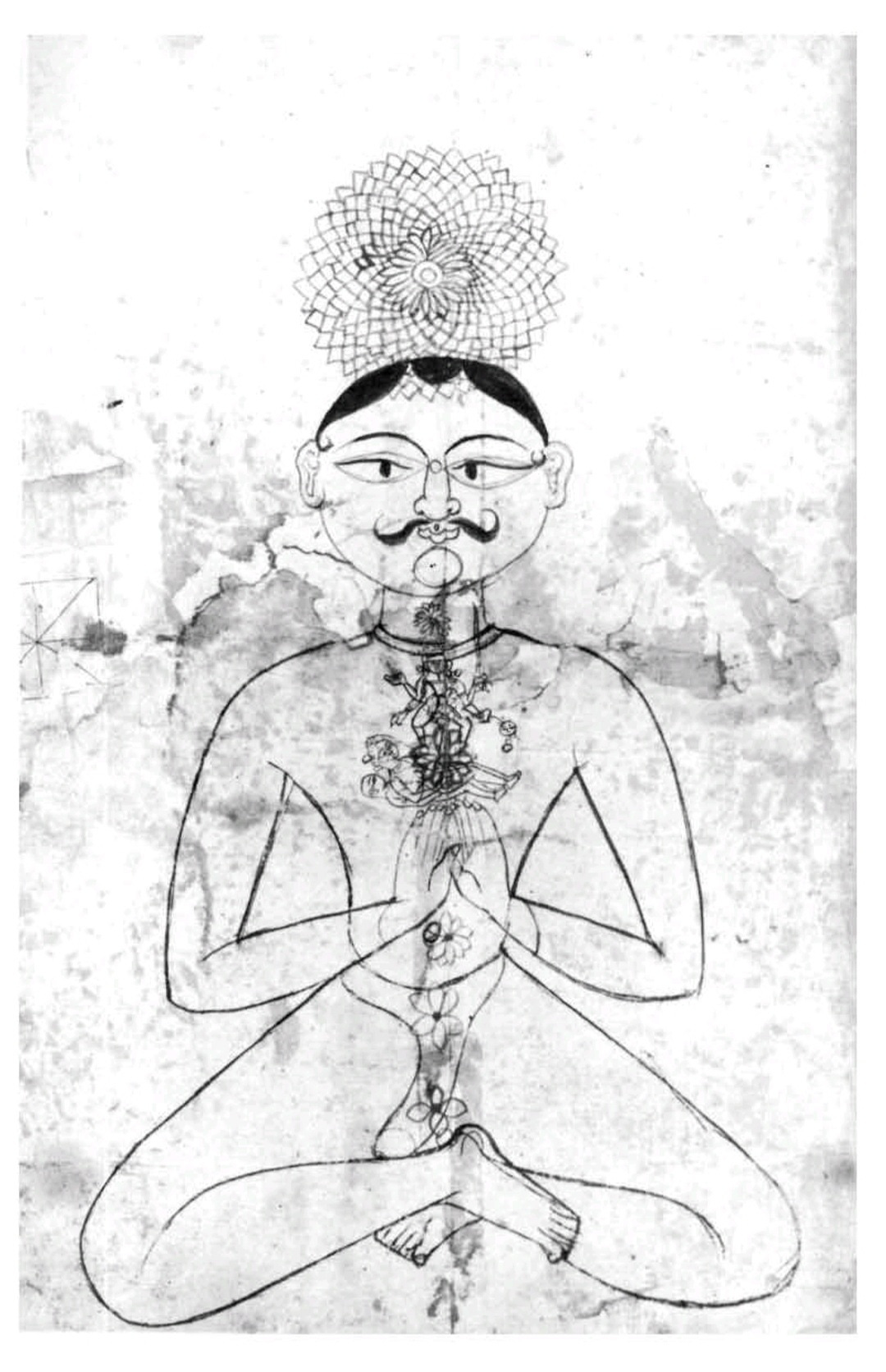
Self-sacrifice, rooted in physiognomy: the perfection of form and metabolic vigor, for performing such acts of spiritual strength requires a worthy vehicle. त्वे विश्वे॑ सहसस्पुत्र दे॒वास—In thee, O son of strength, abide the universal gods. “Their goal was immortality through the perfection of the body,” writes Olson (1980) of the Natha-yogins. The journey toward the sun-door entails a purification, purging, cleansing, beautification of the body.
ਧੀਰਜ ਧਾਮ ਬਨਾਇ ਇਹੈ ਤਨ ਬੁਧਿ ਸੁ ਦੀਪਕ ਜਿਉ ਉਜੀਆਰੈ ॥ ਗਿਆਨਹਿ ਕੀ ਬਢਨੀ ਮਨਹੁ ਹਾਥ ਲੈ ਕਾਤਰਤਾ ਕੁਤਵਾਰ ਬੁਹਾਰੈ ॥
Turn this body into the abode of forbearance, enlighten it with the lamp of intellect. Take the broom of knowledge in your hand, and sweep away the filth of cowardice.
This overfull abundance of energy, brimming with heightened, tensioned spiritual potential, reverberating under Manni’s muscles, in his blood, as he jousted with Partapa, as he flung him and pinned him in the dirt of the wrestling field; tapas, as the strengthening and focusing of power, of the accumulation of sacred white heat, concentrated and pure, within this supreme ascetic. The entirety of one’s being directed towards attaining the highest tonality of one’s virtue (or rather, virtus): this is tapas.
And so, it can be said, was the case with Mangal Singh’s triumphant, fatal swinging of the mace, which rather fittingly was greeted with stunned, almost reverent silence by the crowd of onlookers. Such, perhaps, was also the response that followed Manni Reniwala’s self-annihilating act: an audience of spectators turned into a congregation in the presence of the sacred, of a great yogi attaining the exalted apotheosis of his virtus through tapas.
— — -
A surpassingly glorious end
A complex field of mythical and cultural concepts frames Mangal Singh’s gesta. Shifting our focus from colonial Punjab to Greece in the 5th century BC, we come across Herodotus’s comment on Tellus of Athens as someone he deemed to have lived a worthy life and died a worthy death: “his end was surpassingly glorious,” for he lived to see his country flourish and his sons grow to be beautiful and strong, and “died upon the field most gallantly.” ਜਬ ਆਵ ਕੀ ਅਉਧ ਨਿਦਾਨ ਬਨੈ ਅਤਿ ਹੀ ਰਨ ਮੈ ਤਬ ਜੂਝ ਮਰੋ ॥—When the span of my life arrives at its end, may I perish on the battlefield battling fiercely.
One is also reminded of Giani Gian Singh’s powerful portrayals of Baba Deep Singh and Baba Gurbaksh Singh Nihang preparing for their martyrdom as if they were grooms preparing for their weddings: rubbing their limbs with turmeric paste, tying wedding bands round their wrists to meet their beloved, (God as) Death, and donning plumes on their turbans.
— — -
The consummating death
Nietzsche praised the ‘consummating death’, one undertaken at the correct time, meant to crown the sovereign impulse that dictates one’s striving. Here too one finds the disdain that the Punjabi folk hero harbors towards death, the brash bravado that accents the tales of Jeona Morh, Sucha Soorma, Jagga Jatt, etc. This same irreverence towards his own mortality, one may add, defines Mangal Singh’s heroism.
The pursuit of ‘a maximal feeling of power,’ to acquire the ‘goods of life,’ to achieve lasting renown or kleos (meant to be heard, to be recounted— the bard or poet as the bestower of immortality): a worthy life is fulfilled (immortalized) in a worthy death; a worthy death redeems a life less worthy. “. . . to become a heros, in the Greek context, is to continue to exist beyond death.” (Pache 2009)
— — -
In the cultic landscape of Archaic Greece, heroic individuals would be “posthumously honored as objects of worship and recipients of sacrifice.” (Pache 2009) Epic poetry and hero cults were means to “acculturate death and integrate it into social thought and life.” (Vernant 1991) Fenech similarly notes Punjabi folk religion’s syncretic veneration of “shahids such as . . .’Ali; the sons of ‘Ali, Hasan and Husayn; the . . . Sufi Mansur al-Hallaj, and . . . warrior-martyr Ghazi Miyan of Baraich with as much reverence as . . . Shiva, the Devi, or the Sikh Gurus.”
These figures have occupied a profoundly vital position in Punjab’s devotional universe, functioning as nodes for interaction and transaction between the continuous realms of the mundane and the supramundane (real). Through the cultural memory and ritual gestures of their devotees and admirers, these heroes transcended death; to recite their kleos was to sustain their immortality (immortality, whether it spanned the twelve miles that demarcated one’s des or the length and breadth of the world itself).
One can say the ubiquitous iconographic presence of Sant Bhindranwale, Bhagat Singh, and now Sidhu Moose Wala attest to the ever-enduring nature of hero-worship/martyr-veneration in contemporary Punjab.
— — -
The archetypal Punjabi hero
The Punjabi hinterland’s historical cycles of raiding, rebellion, vendettas, retribution, and blood feuds have been propelled by a distinct culture of violence, framed within codes of martial conduct, honor and competition common to rivaling clans and kinship networks. Writing about the 18th century cultural codes of the Khalsa Sikhs, Dhavan observes: “Such violence was framed within a language of martial honor and valor that at its barest core suggested might is right, but also that God only grants martial characteristics to those who are capable of pursuing them through hard times.”
This fostered the bellicose, proud character of the archetypal Punjabi hero, the Jatt as peasant, rebel and mercenary— willing, even eager, to respond to all affronts to his honor and clan with cycles of brutality and vicious payback. The title of Randhawa’s story ਰੰਨ, ਤਲਵਾਰ ਤੇ ਘੋੜਾ— Woman, Sword and Horse, concisely encapsulates ‘the goods of life’ for the Punjabi hero.
— — -
The Sikh martyr
This set of characteristics, already firmly entrenched in the Punjabi psyche, fed into the Khalsa’s dynamic martial ethos as the Singhs outlasted and ousted all opposition in Punjab. Guru Hargobind’s militarization reforms brought what McLeod terms ‘Jat cultural patterns’ of violence into the Sikh political machinery; these patterns of acquisitive, competitive, almost nihilistic violence in turn were conditioned by noble ideals of classical kshatriyata that underpinned the Khalsa’s solar telos of sovereignty.
The Sikh tradition of martyrdom can be said to embody all these disparate elements of the consummating death, heroism, kleos, tapas, the veneration of the martyr as a divine intermediary, etc. This presentiment of martyrdom colors the Singh’s conduct, and affirms the defence of dharam, even to the point of death, as the highest virtue, one that he must orient and focus the entirety of his being towards. This is the defining gesta he meditates on.
Guru Tegh Bahadur, one of the earliest and most honored Sikh martyrs (and certainly the first to be eulogized in verse by Guru Gobind Singh) paints in these blessed verses the archetypal, highest ideal of the martyr, the hero, the yogi, the ascetic, at once dead and brimming with life, supremely overfull with the pure heat of tapas:
ਜੋ ਨਰੁ ਦੁਖ ਮੈ ਦੁਖੁ ਨਹੀ ਮਾਨੈ ॥ ਸੁਖ ਸਨੇਹੁ ਅਰੁ ਭੈ ਨਹੀ ਜਾ ਕੈ ਕੰਚਨ ਮਾਟੀ ਮਾਨੈ ॥੧॥ ਰਹਾਉ ॥— The man, who in the midst of pain, does not know pain; affected by neither bliss, affection nor fear, seeing gold as dirt; [Pause]
ਨਹ ਨਿੰਦਿਆ ਨਹ ਉਸਤਤਿ ਜਾ ਕੈ ਲੋਭੁ ਮੋਹੁ ਅਭਿਮਾਨਾ ॥ ਹਰਖ ਸੋਗ ਤੇ ਰਹੈ ਨਿਆਰਉ ਨਾਹਿ ਮਾਨ ਅਪਮਾਨਾ ॥੧॥— Swayed by neither slander nor praise, unaffected by greed, attachment or pride; detached from pleasure and sorrow, from honor and dishonor alike;
ਆਸਾ ਮਨਸਾ ਸਗਲ ਤਿਆਗੈ ਜਗ ਤੇ ਰਹੈ ਨਿਰਾਸਾ ॥ ਕਾਮੁ ਕ੍ਰੋਧੁ ਜਿਹ ਪਰਸੈ ਨਾਹਨਿ ਤਿਹ ਘਟਿ ਬ੍ਰਹਮੁ ਨਿਵਾਸਾ ॥੨॥— Renounces hope and desire entirely and remains desireless in the world; whom sexual desire or anger cannot touch: within his heart, Brahm dwells.
ਗੁਰ ਕਿਰਪਾ ਜਿਹ ਨਰ ਕਉ ਕੀਨੀ ਤਿਹ ਇਹ ਜੁਗਤਿ ਪਛਾਨੀ ॥ ਨਾਨਕ ਲੀਨ ਭਇਓ ਗੋਬਿੰਦ ਸਿਉ ਜਿਉ ਪਾਨੀ ਸੰਗਿ ਪਾਨੀ ॥੩॥੧੧॥— The man whom the Guru's grace favors, he recognizes this way; O Nanak, he merges with Gobinda like water does with water.
— — -




